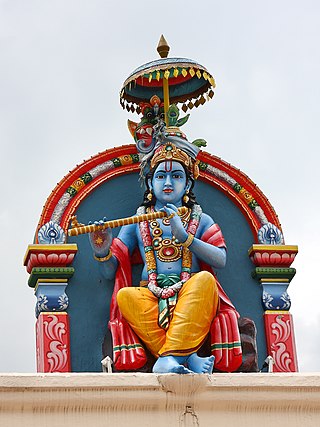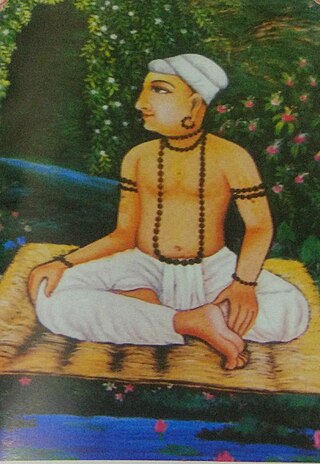
Krishna is a major deity in Hinduism. He is worshipped as the eighth avatar of Vishnu and also as the Supreme God in his own right. He is the god of protection, compassion, tenderness, and love; and is widely revered among Hindu divinities. Krishna's birthday is celebrated every year by Hindus on Krishna Janmashtami according to the lunisolar Hindu calendar, which falls in late August or early September of the Gregorian calendar.

Radha, also called Radhika, is a Hindu goddess and the chief consort of the god Krishna. She is the goddess of love, tenderness, compassion, and devotion. In scriptures, Radha is mentioned as the avatar of Lakshmi and also as the Mūlaprakriti, the Supreme goddess, who is the feminine counterpart and internal potency of Krishna. Radha accompanies Krishna in all his incarnations. Radha's birthday is celebrated every year on the occasion of Radhashtami.

Bhajan refers to any devotional song with a religious theme or spiritual ideas, specifically among Dharmic religions, in any language. The term bhajanam means reverence and originates from the root word bhaj, which means to revere, as in 'Bhaja Govindam' . The term bhajana also means sharing.

Gaudiya Vaishnavism, also known as Chaitanya Vaishnavism, is a Vaishnava Hindu religious movement inspired by Chaitanya Mahaprabhu (1486–1534) in India. "Gaudiya" refers to the Gaura or Gauḍa region of Bengal, with Vaishnavism meaning "the worship of Vishnu". Specifically, it is part of Krishnaism—Krishna-centric Vaishnavite traditions.

The Radha Vallabha Sampradaya is a Vaishnava Hindu denomination which began in 1535 at Vrindavan with the bhakti sant Hith Harivansh Mahaprabhu (1502–1552). Harivansh's views are related to Krishnaism, but emphasises devotion to the goddess Radha as the Supreme Being.

Vallabha, or Vallabhācārya was an Indian saint and philosopher. He founded the Kr̥ṣṇa-centered Puṣṭimārga sect of Vaishnavism in the Braj (Vraja) region of India, and propounded the philosophy of Śuddhādvaita.

The Puṣṭimārga or Pushtimarg, also known as Vallabha Sampradāya, is a sect of Vaishnavism. It was founded in the early 16th century by Vallabha (1479–1531) and was later expanded by his descendants, particularly Viṭṭhalanātha. Pushtimarg adherents worship Kr̥ṣṇa, and tradition follows universal-love-themed devotional practices of youthful Krishna which are found in the Bhagavata Purana and those related to pastimes of Govardhana Hill.

Radha-Krishna is the combined form of the Hindu god Krishna with his chief consort and shakti Radha. They are regarded as the feminine as well as the masculine realities of God, in several Krishnaite traditions of Vaishnavism.

Shuddadvaita is the "purely non-dual" philosophy propounded by the Hindu philosopher Vallabha, the founder of Puṣṭimārga, a Vaishnava tradition focused on the worship of the deity Krishna. Vallabhacharya's pure form (nondualist) philosophy is different from Advaita.

Vaishnavism is one of the major Hindu denominations along with Shaivism, Shaktism, and Smartism. It is also called Vishnuism since it considers Vishnu as the sole supreme being leading all other Hindu deities, that is, Mahavishnu. Its followers are called Vaishnavites or Vaishnavas, and it includes sub-sects like Krishnaism and Ramaism, which consider Krishna and Rama as the supreme beings respectively. According to a 2010 estimate by Johnson and Grim, Vaishnavism is the largest Hindu sect, constituting about 641 million or 67.6% of Hindus.

Krishnaism is a term used in scholarly circles to describe large group of independent Hindu traditions—sampradayas related to Vaishnavism—that center on the devotion to Krishna as Svayam Bhagavan, Ishvara, Para Brahman, who is the source of all reality, not an avatar of Vishnu. This is its difference from such Vaishnavite groupings as Sri Vaishnavism, Sadh Vaishnavism, Ramaism, Radhaism, Sitaism etc. There is also a personal Krishnaism, that is devotion to Krishna outside of any tradition and community, as in the case of the saint-poet Meera Bai. Leading scholars do not define Krishnaism as a suborder or offshoot of Vaishnavism, considering it at least a parallel and no less ancient current of Hinduism.

The Nimbarka Sampradaya, also known as the Kumāra Sampradāya, Hamsa Sampradāya, and Sanakādi Sampradāya, is one of the four Vaiṣṇava Sampradāyas. It was founded by Nimbarka, a Telugu Brahmin yogi and philosopher. It propounds the Vaishnava Bhedabheda theology of Dvaitadvaita (dvaita-advaita) or dualistic non-dualism. Dvaitadvaita states that humans are both different and non-different from Isvara, God or Supreme Being. Specifically, this Sampradaya is a part of Krishnaism—Krishna-centric traditions.
Svayam Bhagavan is a Sanskrit concept in Hinduism, referring to the absolute representation of Bhagavan as the Supreme God in a monotheistic framework. The concept is most commonly associated with a male deity, for instance in Hindu sub-movements like Krishnaism and Gaudiya Vaishnavism, in which Krishna is regarded as Svayam Bhagavan.
Prabodhananda Sarasvati was a Gaudiya Vaishnava, and later Radhavallabha, sannyasi.
Venkatta Bhatta - Gaudiya Vaishnava is famous for being part of the conversion from worship of Laksmi-Narayana to worship of Krishna as Svayam bhagavan. In Chaitanya Charitamrita 2.9.108-124 and further on Chaitanya talks about Krishna's supremacy in a joking mood with Venkatta Bhatta. Also notable for being the father of Gopala Bhatta.

Radha Ramana is one of the combined forms of the Hindu deities Radha and Krishna, besides their BankeBihari and Radha-Vallabha forms.
Hindu denominations, sampradayas, traditions, movements, and sects are traditions and sub-traditions within Hinduism centered on one or more gods or goddesses, such as Vishnu, Shiva, Shakti and so on. The term sampradaya is used for branches with a particular founder-guru with a particular philosophy.

Hariram Vyas was a 16th-17th century spiritual poet, classical musician and saint belonging to the Radha Vallabh Sampradaya. He is known to have revealed the Vigraha or Shri Jugal Kishore ji, which is today in Panna, from a well in Kishore Van in Vrindavan.

Shri Radha Vallabh Temple, also called Shri Radha Vallabhlal ji Temple is a historic temple in the city of Vrindavan, Mathura district, Uttar Pradesh, India. The temple is dedicated to Hindu deities Radha Krishna. The temple belongs to Radha Vallabh Sampradaya and was constructed in 16th century under the guidance of Vrindavan saint Hith Harivansha Mahaprabhu.

The Ashtasakhi are a group of eight prominent gopis and close associates of the Hindu deities Radha-Krishna in the Braj region. In many sub-traditions of Krishnaism, they are revered as goddesses and consorts of Krishna. According to the Padma Purana, the Ashtasakhi are the eternal female companions of Radha-Krishna in the Dvapara Yuga, with whom they descended upon the earth from their celestial abode of Goloka.













